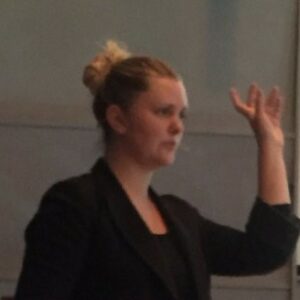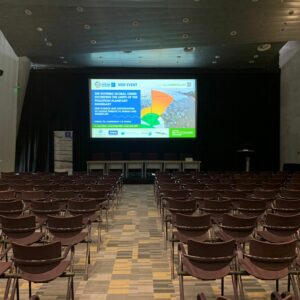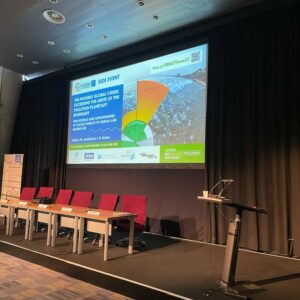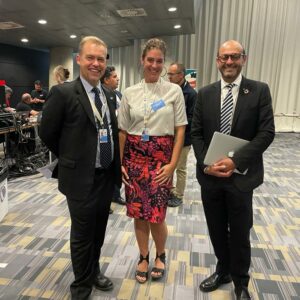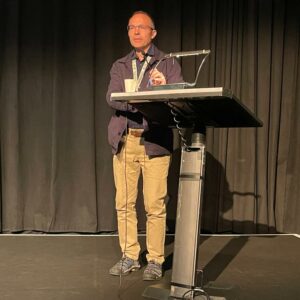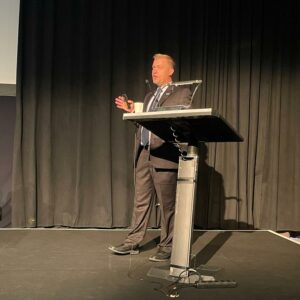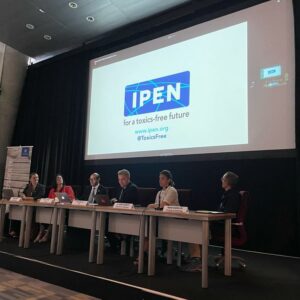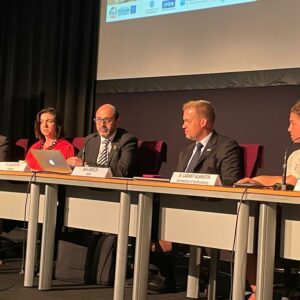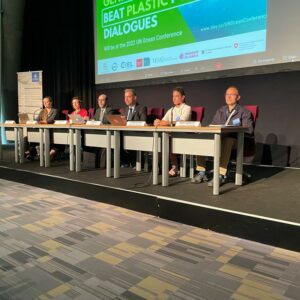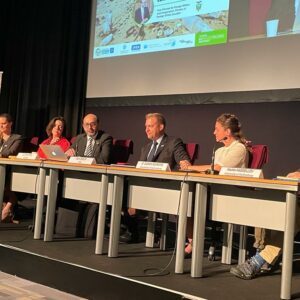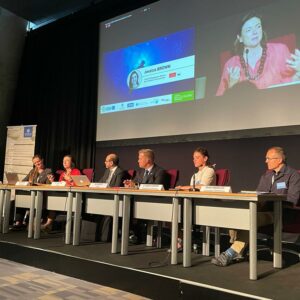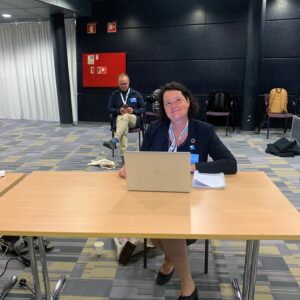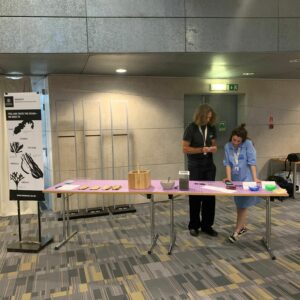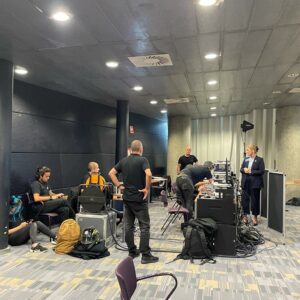Événement Conférence
The Invisible Global Crisis: Exceeding the Limits of the Pollution Planetary Boundary – New Science and Opportunities to Tackle Threats to Human and Marine Life | UN Ocean Conference Side Event
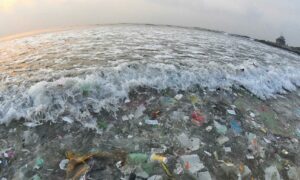
27 Jun 2022
14:30–16:00
Lieu: Lisbon | FIL, Auditorium 1 & Online
Organisation: International Pollutants Elimination Network, University of Gothenburg, Swedish Institute for Marine Environment, Western Indian Ocean Marine Science Association, Geneva Environment Network
This official side event to the UN Ocean Conference was organized by the International Pollutants Elimination Network (IPEN), University of Gothenberg, Swedish Institute for Marine Environment & Western Indian Ocean Marine Science Association (WIOMSA) in collaboration with the Geneva Beat Plastic Pollution Dialogues. The event took place in hybrid format, physically in Lisbon and online (13:30-15:00 Lisbon time, 14:30-16:00 Geneva time).

About this Session
The planetary boundaries concept presents a set of nine boundaries that when crossed increases the risk of generating large-scale abrupt or irreversible environmental changes. The ocean is the chemical sector’s global dumpsite, where beyond the visible plastic pollution, new science is revealing a much more insidious global threat: the escalating chemical production and invisible pollution crisis.
In 2022 the crisis was revealed as the planetary boundaries of chemical pollution were assessed and published in the study Outside the Safe Operating Space of the Planetary Boundary for Novel Entities. In this innovative peer reviewed publication, a group of 14 internationally renowned scientists concluded that rates of production and release of hazardous chemicals used to make plastics, pesticides and industrial chemicals exceeds these boundaries.
These results are of grave concern, as the stability of global ecosystems upon which humanity depends is on course to collapse. For this event, the researchers behind the paper introduced and discussed this complex problem describing the main drivers of pollution and its consequences. Further they discussed how pollution influences biodiversity integrity and how this is reflected in a social-human dimension. The current chemical production rates far exceed our ability to assess and regulate safety of chemicals and products, and waste management policies and infrastructures cannot prevent release into the environment.
The researchers are calling for ambitious action capping new production of plastics. Policy makers, international media actors and public interest stakeholders joined the conversation with a focus on how to scale up the action based on science, collective action, policy and management. The main goal of this side-event and contribution to the conference is to form new partnerships, communicate the need for a more progressive chemical policy and management and to speed up the formation and implementation of an International Panel on Chemical Pollution, IPCP.
The Geneva Beat Plastic Pollution Dialogues
![]()
The world is facing a plastic crisis, the status quo is not an option. Plastic pollution is a serious issue of global concern which requires an urgent and international response involving all relevant actors at different levels. Many initiatives, projects and governance responses and options have been developed to tackle this major environmental problem, but we are still unable to cope with the amount of plastic we generate. In addition, there is a lack of coordination which can better lead to a more effective and efficient response.
Various actors in Geneva are engaged in rethinking the way we manufacture, use, trade and manage plastics. The Geneva Beat Plastic Pollution Dialogues aim at outreaching and creating synergies among these actors, highlighting efforts made by intergovernmental organizations, governments, businesses, the scientific community, civil society and individuals in the hope of informing and creating synergies and coordinated actions. The dialogues highlight what the different stakeholders in Geneva and beyond have achieved at all levels, present the latest research and governance options.
Following the landmark resolution adopted at UNEA-5 to end plastic pollution and building on the outcomes of the first two series, the third series of dialogues will encourage increased engagement of the Geneva community with future negotiations on the matter. These include the meetings of the Intergovernmental Negotiating Committee (INC) from the second half of 2022 to 2024, as well as preparatory meetings within the ad-hoc open-ended working group during the first half of 2022. The series will also continue to foster stronger cooperation and coordinated actions ahead of other milestones in the environmental agenda, including the BRS COPs, SAICM ICCM5, the 2022 UN Ocean Conference, UNEA-6 and other processes in Geneva, such as at the WTO.
Speakers
By order of intervention

Prof. Lena GIPPERTH
Professor in environmental law and member of the Centre for Sea and Society, University of Gothenburg | Moderator

Prof. Martin HASSELLÖV
Professor in Analytical Environmental Chemistry, Department of Marine Sciences, University of Gothenburg

Prof. Bethanie CARNEY ALMROTH
Professor in Ecotoxicology, Department of Biological and Environmental Sciences, University of Gothenburg

Björn BEELER
General Manager and International Coordinator, International Pollutants Elimination Network (IPEN)

H.E. Luis VAYAS
Vice-Minister for Foreign Affairs and Cooperation, Ministry of Foreign Affairs, Ecuador
Summary
Prof. Lena GIPPERTH | Professor in environmental law and member of the Centre for Sea and Society, University of Gothenburg | Moderator
Chemicals have improved our lives in many ways, but most of the chemicals contained in plastics bring severe risk to humans, even before being born, and to the marine environment. The new science about novel entities exceeding the limits of the pollution planetary boundaries due to releases of hazardous chemicals regards crisis but also opportunities to tackle threats to human and marine life.
Prof. Martin HASSELLÖV | Professor in Analytical Environmental Chemistry, Department of Marine Sciences, University of Gothenburg
The planetary boundary concept refers to a science-based anthropocentric assessment framework that takes a holistic Earth System Science view on the planet and its systems. As planetary boundaries assess the key components that regulate the stability and the resilience of the earth’s systems, the framework can be seen a science-based threshold underpinning the safe operating space for humanity. In other words, it evaluates how much anthropogenic abuse the planet can take before the life support system for humanity is at risk. The framework identifies nine planetary boundaries: climate change, biosphere integrity, land-system change, freshwater use, biochemical flows (phosphorus and nitrogen), ocean acidification, atmospheric aerosol landing, stratospheric ozone depletion and novel entities.
The impact of chemical pollution is assed under the “novel entities” boundary which adopts a holistic view of pollution. Novel entities include new substances and new forms of existing substances, thus all chemicals and other new types of materials that was not been previously known to the earth and biological systems. These include plastics, engineered nano materials and natural occurring elements like heavy metals remobilized by anthropic activities. The concepts of planetary boundaries and pollution might seem distant from one another because the idea of pollution of an entire planet is hard to grasp. The widespread image of the planet composed of wide stretches of ocean and pristine places and atmosphere to dilute any pollution raises confidence that pollution is strictly connected to visible anthropic effects. However, according to the Steffen et al., novel entities are a “global concern when exhibiting persistence, mobility across scales with widespread distribution and accumulation in organisms and the environment, and potential negative impacts on vital Earth Systems processes or subsystems”. The multi-author study by the University of Gothenburg “The Invisible Global Crisis: Exceeding the Limits of the Pollution Planetary Boundary” aims to provide a first assessment of the novel entities boundary.
Evidence of this kind of pollution can be found on Henderson Island for instance. This small island in the middle of the South Pacific is home to several bird species but no humans. It is thousands of kilometers from the nearest continents, but it is flooded with marine litter and plastic debris. Plastic pollution tends to show up in the most unexpected places, like microplastics found in the ice and deepest waters of the North Pole, Antarctica and Greenland. Plastics will distribute with the ocean currents in the most unexpected places.
Comprehensive monitoring programs for pollution often do not include heavy metals. However, research on transact the Atlantic ocean shows pervasive lead pollution crossing from the Arctic to the Antarctic. That transport leaks down into the deeper ocean. The lead is coming from anthropogenic input, most likely loaded gasoline. The decision to add lead to gasoline was taken a hundred years ago, despite knowledge of its harm to human brain development and of the existence of available alternatives. It took more than fifty years of global use before some countries decided to lower its use and several more decades before it was regulated in most countries. Lead represents one example of a lock-in effect and of how global pollution moves around the globe.
Natural processes like ocean currents and atmospheric mouvements also transport pollutants around the globe including semi-volatile compounds such as many of the persistent organic pollutants. They are volatized in the near the tropics and then condensed further to Northern high latitudes, leading to accumulation and high concentration in the arctic biota and ecosystems. The development on the information about transport around the globe contributed to a perspective shift on pollution over the years. From the idea of careless or unmanaged practices leading to big problems in localized area, we are now more aware of the various compounds coming from society and how their effect propagate beyond specific areas. Wang et al. (2020) looked at all chemicals’ inventories and concluded there is more than 10,000 chemicals in society as was previously believed, but 50,000 that are confidently described instead. Besides those, about 70,000 are ambiguously described. Weisinger et al. (2021) scrutinized 63 different types of data sources on chemicals in plastics and could allocate 10,000 substances used in plastics and out of those, over 2400 are persistent and have hazardous profiles. The additives in plastics are not the only problem; it’s also about the chemicals associated to it.
Prof. Bethanie CARNEY ALMROTH | Professor in Ecotoxicology, Department of Biological and Environmental Sciences, University of Gothenburg
We know a lot about the global spread of plastics, but we have a lot of unknowns regarding the chemicals that are used in production and those that are in plastic materials. Kristiansson et al. (2021) analyzed 130, 000 different scientific papers looking at the kinds of chemicals in use and their effects. However, the 3,500 chemicals reviewed in 1,300 studies amount to only 1% of the chemicals that are in production and are mostly pharmaceuticals, biocides, metals, plant production products, and REACH substances. These are chemicals under European chemicals legislation. Other studies indicate that when looking at drivers of global change, the number of studies addressing chemicals as a driver is less than 5%. We are unaware of the chemicals out there, where they are going and what their effects are, especially on the environment. There are only 65 chemicals which impacts in the environment are well known. Considering there are 350,000 chemical substances, there is a vast knowledge gap which also complicates understanding how novel entities are affecting the planet. To examine boundaries, the current situation is compared to values in seem-like periods, such as temperature, carbon dioxide levels, the PH in the ocean, and how that changed in the Anthropocene. That could not be done with novel entities because they did not exist before humankind. Instead, we looked at the chemicals and products through their life cycle from extraction to disposal.
Novel entities can leak into the environment during each stage of the life cycle. We developed an impact pathway to assess what these substances do in the environment and scaling this information up from a short time period at a local scale to something global. It goes from extraction to production of novel entities and to release into the environment. The pathway aims to understand how novel entities feed and distribute, and their impact and disturbances to earth system processes. This moved us from a technological domain into the environmental one. In this impact pathway, we identified three control variables instrumental to understanding what is going on at planetary scale and these are 1) production and use volumes; 2) environmental mass and or concentrations; and 3) earth systems effects. These eventually allow to comprehend the planetary boundaries and whether they have been transgressed. Data selection was a complex part of this operation and was done against the criteria of feasibility, relevance, and comprehensiveness.

In terms of findings in the technological sphere, the production volumes of chemicals and plastics containing different chemicals is increasing and will continue to. This regards the share of chemicals on the market that have regulatory data or being assessed. The regulatory assessment framework from the European Chemicals Legislation REACH (Registration, Evaluation, Authorisation and Restriction of Chemicals) assessed that out of the 350,000 chemicals registered for production, about 143,000 are found on the European market. REACH legislation requires chemicals to be submitted as dossiers when produced or imported over one thousand kilos per year. Only 48, 000 dossiers were submitted with toxicity data on the hazards of these chemicals. The European Chemicals Agency strives to check 25% of those and 75% were lacking in important information. This represents a further knowledge gap on the toxicity of the chemicals we use.
In terms of release, within the environmental domain, we looked at emissions of plastics and hazardous chemicals. Borrelle et al. (2020) set the baseline level at 8 million tons per year, which is the number of plastics released into the environment in 2010. That represents the goal although it is already a high number. If plastic and chemical production continues and increases so will the amount of waste in the environment. This could be reduced with very ambitious strategies to plastic production and use, but even so leakage into environment will persist. This study also assessed differences between countries, reflecting consumption patterns, economies, and waste management infrastructure. Annual global plastic emissions into the aquatic systems are not evenly distributed across the globe.
To assess the impacts of plastic pollution on the environment from the toxicity of chemical pollution and disturbances to the biosphere, let’s consider two examples: one pesticide and BPA, a polymer used in plastics. Peter Funka, one of the co-authors of the study, looked at their production volumes, uses, emissions to the environment air, land, and soil and the toxicity of those chemicals. Those two chemicals occupy one-thousandth of the safe space for chemicals in freshwater systems in Europe. And those are only two out of 350000. We also looked at how the chemicals and plastics connect to other planetary boundaries to see how chemicals are affecting the stability and health of the planet in other ways. For example, chemicals have been pointed out as a driver of biodiversity loss in adding a stressor to already stressed organisms across the planet. Chemicals are changing microbial communities and different water systems in the ocean environment. They are contributing to climate change because plastics are made from fossil fuels. So, plastics are sometimes referred to as “climate change in solid form”. Novel entities are connected to ocean acidification and to changes in land use and nitrogen and phosphorus flow through chemical production.
According to the control variables employed in the impact pathway, we have exceeded the boundaries and we are beyond the safe operating space. We are currently destabilizing Earth’s processes through the production and use of chemicals and plastics which is highly unregulated and mismanaged. The article published in The Guardian gathered much media attention, meaning that people care about this issue and wish to hear more about it. We also need to beat chemical pollution because people around the world are worried about this.
Björn BEELER | General Manager and International Coordinator, International Pollutants Elimination Network (IPEN)
Most people think about plastic pollution through what is visible but that represents just the tip of the iceberg. IPEN is a global network of organizations, working on both global policy and local realities. Many of the people working for IPEN are founders of their organizations because they wish to protect the ocean and the people in their communities from toxic chemicals and pollutants. IPEN’s mission is a toxic-free future for all. To do so, IPEN generates information and data at the local level to bring it to international venues and policy spaces to generate policy change and leverage financial and technical resources for work to change the reality on the ground. The target of policy change is the public, which includes public spaces like the ocean. We have broken through planetary boundaries and the impacts of chemicals on the environment are a threat to life. This is not the first time the international arena faces such a situation. Some years ago, the chemicals are known as persistent organic pollutants (POPs) were discovered to be an intergenerational danger as they can move from mother to child. POPs begin to be addressed in 1998 at a global policy level after a strong popular movement to halt them. The Stockholm Convention began by banning twelve chemicals known as the Dirty Dozen. Since then, thirty-one new chemical substances or groups of substances hazardous to the environment have been added. Some of these are connected to the production of plastics as well as the release of plastic waste.
The connection between pesticides and the ocean may not be self-evident, rather it is invisible. Pesticides or poisons are dumped into the environment into the ground and run off into waterways. The downstream waterway represents the livelihoods of most, as it impacts fisheries among other things. Pesticides are meant to kill pests or insects, which are part of the food chain. The food chain getting poisoned by pesticides and its connection to the collapse of fisheries has been recently reported also on the news. In 2018, IPEN published the report “Ocean Pollutants Guide Toxic Threats to Human Health and Marine Life” and one of the findings indicated that “persistent herbicides are believed to pose one of the greatest risks to ecosystems and organisms in the Great Barrier Reef”.
Plastics are much more evident and recognized polluters of the marine environment and a threat to human health. Plastics are made of carbon, oil, gas, and chemicals combined. It is impossible to have plastics without chemicals. Many chemicals are recognized to be harmful, and the list might be longer as not all chemicals have yet been assessed. The chemicals used for plastic production that threaten the ocean and human health are both visible and invisible. Invisible ones are toxic chemicals, which were addressed in the report “Aquatic Pollutants in Oceans and Fisheries” published by IPEN in 2021. The report claims that “the fertility of male fish decreased as bioconcentrated persistent endocrine disrupting chemicals”. Endocrine-disrupting chemicals (EDCs) are changing hormone system of this marine life. Toxic chemicals threaten fisheries by impairing the ability of marine life to reproduce. If we look at the plastics life cycle, going from extraction to recycling, plastic pollution seems to be coming from ocean dumps. To assess their real danger, the additives used in plastics must be considered. The plastic production process inputs chemicals since its initial stage.
Chemical and plastics production is set to skyrocket. The book “The Count Down”, shows the correlation between the growth of PFAS (Perfluoroalkyl and Polyfluoroalkyl Substances), BFRs (brominated flame retardants), Phthalates and BPA (Bisphenol A) and fertility decreases. Reports and documents show worldwide fertility has dropped more than 50% over the past 50 years and continues to decline. To address this situation, last year IPEN launched various local monitoring programs in collaboration with local organizations. Plastics collected on beaches were tested for POPs, which were found in all samples as well as endocrine-disrupting chemicals. From the analysis of plastics products, it resulted in that baby bottles contain BPA, toys inflame retardants, and clothing PFAS with the Forever Chemicals.
This information should be alarming but not a reason to lose hope. The first step to getting out of this situation is to identify the common problem discuss the solutions, create rules and laws, and enforce these laws. The problem is global chemical pollutants and possible solutions are controls. The opportunity for control is for instance the resolution passed at UNEA-5.2 in February where the Global Community agreed to negotiate a treaty on plastics. A plastics treaty provides an opportunity to protect human health and the environment from toxic chemicals used to make plastics, as well as ban the production of harmful chemicals used to make plastics. This can produce a shift of responsibility from the public who is asked to recycle and clean up the beaches, to the producers of these chemicals and plastic products. Toxic chemicals are increasing because plastics are made of carbon and chemicals. Many of those chemicals are harmful and a treaty to ban plastic pollution is an opportunity. In the words of Greta Thunberg, “instead of looking for hope, start creating the hope yourself.”
Jessica BROWN | Head of Engagement, Back to Blue Initiative, The Economist
“The Invisible Wave” Report gathers insight from more than 100 stakeholders from policy-making, the private sector, scientists and NGOs, looking into how big a problem marine chemical pollution is and what should be done about it. The scientific community and NGOs provided stories similar to those previously presented during this event, highlighting we are facing an urgent crisis that needs to be addressed immediately. The gap between that perspective and the perspective of governments, businesses and investors, which claimed not to be aware of this issue, is striking. They claimed to be familiar with the issues related to plastics but not about chemical pollution in the ocean. This entails that no action to halt it has been taken in this regard. This represents an issue as this problem cannot be addressed with the required urgency if decision-makers do not even have it on their agenda.
Data gaps and scatteredness represent one of the main issues. The capacity to develop relevant data is concentrated in the parts of the ocean that surround developed countries, where the research capacity is higher. It is up to debate whether this data is compelling or rigorous enough to make regulatory decisions. Data gap is a real problem which needs to be overcome and one way to do so could be by having a global register of chemicals and a science-policy body. Data gaps are important to fill also to assess the financial, human health and ecosystem services costs of marine chemical pollution. Unless this problem cannot be translated into figures, it will be hard to make a compelling argument to decision-makers and businesses. The Invisible Wave study contains small economic modelling looking at the Gulf of Mexico. We were only able to do a very small piece because it is almost impossible to patch all the data together. Just from that case study, we found that there are 838 million dollars in lost revenue each year to the US fisheries industry alone. If you extrapolate that out, the cost of chemical pollution in the ocean is enormous.
To communicate this more effectively to decision-makers, we would like to embark on a project to develop a global map of currently available data to identify gaps and costs. The first obstacle to combat is the lack of awareness. Even during the UN Ocean Conference taking place in Lisbon this week, there are very few events dedicated to marine chemical pollution. That is not complemented by the focus on plastics as that is just a subset of the problem. Chemicals pollution needs to be high on the next UN agenda. As it happened with the plastic issue, chemical pollution should become a sexy issue, appealing to emotion. During the interviews for The Invisible Wave report, many interviewees spoke about the Blue Planet effect, referring to the BBC series narrated by David Attenborough, which overnight propelled plastic pollution in the ocean into public consciousness. One idea to build that moment for chemical pollution might come from the Strawless campaign launched in Seattle. The organizers were aware it was not going to solve the plastics problem, but they believed in the potential of a solution people can own. If people stop using straws, they will bring it into conversations and maybe create a trend to halting single-use plastics. Doing the same for chemical pollution might be harder as it entails making visible something that is invisible. Awareness is the most urgent step to be taken, followed by closing the data gap and the perception gap between science and decision-makers.
H.E. Luis VAYAS | Vice-Minister for Foreign Affairs and Cooperation, Ministry of Foreign Affairs, Ecuador
A treaty on plastic pollution must not be a missed opportunity to address chemicals and plastic pollution. Plastic pollution is an aggravator of the triple planetary crisis of loss of biodiversity, climate change and pollution. The amount of plastic in the ocean compares to the surface of France, and that should make us freak out. Freak out means wrapping our heads around the problem and having scientists, politicians, negotiators, and diplomats engaged to solve it. This means having the scientific community guiding the negotiations of the treaty on plastic pollution. As many other intergovernmental bodies are being guided by scientific bodies, the treaty should build on the expertise and items already negotiated by these. The use of chemicals to produce plastics must be quickly addressed. Life starts in the ocean and humanity comes from there. We are now dumping chemicals and plastic trash back into the oceans. We must use the data brought us by the scientific community, bring it to the negotiation table and create solutions out of it. As the UNEA-5.2 resolution highlights, we must take a life cycle approach to plastics, because other solutions are just partial. Since 2000, the production of plastics in the world doubled. We are suffocating the earth with plastics. We just freak out and do not miss any of the opportunities ahead. We see world patrimonies, especially islands being threatened by plastic pollution. Scientific evidence is strong and it must be an essential tool to use in multilateral decision-making for the treaty to be soon negotiated by the International Negotiating Committee (INC).
Therese KARLSSON | Science and Technical Advisor, IPEN
The Basel, Rotterdam and Stockholm Conventions Conference of the Parties (BRS COPs) recently met in Geneva. The international community came together to make decisions about some of the most toxic chemicals in the world, about our future and our health, which is closely linked to oceans health. The oceans are still acting as global dumping grounds for the chemicals we use and produce. If we do not address toxic chemicals in the oceans, it will not be possible to restore ecosystems and fish stocks. Toxic chemicals are an invisible and often overlooked crisis because they cannot be seen. If chemicals cannot be seen, we need to talk about them more to make the invisible visible. Chemicals must be addressed as groups because addressing each alone is time-consuming, and often banned chemicals get substituted for other equally toxic chemicals.
At BRS COPs this year, one important step forward was taken. The PFHxS (Perfluorohexanesulphonic acid) group of chemicals was listed for elimination. These chemicals have been used in firefighting foams in food packaging, in clothing and are very persistent and toxic. That is a great step forward, but they are only a small group within the larger group of Forever Chemicals, PFAS. These chemicals are found in the human blood of all and must be addressed as an entire to protect future generations and the oceans. Finally, the area that I spend years studying. I started working with plastic pollution because I sailed across the Atlantic. During that trip, almost every day, we would see plastic floating by our boat. I started working on plastics focusing on the visible problem, but the impacts of plastics actually come from the chemicals. Addressing plastic issues requires talking both about visible and invisible parts. In order to safeguard future generations and our ocean, we need to talk about chemicals with colleagues, governments and friends to make them visible and to push for global controls. When it comes to policy, decisions must be taken about groups of chemicals and not look at them one by one.
Jessica BROWN | Head of Engagement, Back to Blue Initiative, The Economist
Policy making on chemicals at a national level is as important as the international one and it tends to be very reactive. There are a few principles that can be used to design policies and regulations at a national level: regulating chemicals in groups and introducing the precautionary principle. The pace of innovation in the chemical sector is much faster than the one in the regulatory spaces. Regulation needs to be flexible and designed for future changes. At the moment, the onus to prove that a particular substance is harmful is on regulators. Introducing the precautionary principle allows switching that onus onto producers and users. The REACH legislation in the EU is a great example but it represents an exception. Its diffusion in other parts of the world is critical but dependent on geography. By 2030, 50% of the projected growth of chemicals will be in Asia. Commercial innovation is happening in a different place from where the regulatory innovation is. It is important to ensure that regulations do not allow global companies to move their operations to places where regulation is less onerous. Designing legislation is not enough, it needs to be implemented and enforced.
Chemicals are one of the biggest industries in the world. The solution is not regulating the industry out of existence but supporting it to transition. Chemicals are in 95% of manufactured products in the world. Change is going to be very complex, long-term and expensive, as much as the energy sector’s change to deal with climate change. The chemicals sector must be put in a situation where there are economic incentives and profits to be made from transitioning. We are already seeing there is a growing market for products that will help other industries undergo their sustainable transitions. For example, BASF, the world’s largest chemical producer, claims that by 2025 one-third of its products will be in this category. Sumitomo Chemical in Japan says that now 20% of its revenue comes from sustainable solutions. From the interviews conducted for the Invisible Wave report, it seems that the chemicals industry still sees itself as the center of innovation it once was. Others are aware chemicals are now part of the problem rather than part of the solution. It is also necessary to get a cultural change within these organizations for them to re-harness that spirit of innovation to solve this new problem.
Green chemistry is one way to do that as it develops chemicals that reduce or eliminate the harmful qualities altogether. Chemicals are a low margins business. To be successful, you need scale. Therefore, green chemicals must not be confined to the startup scene, big chemical companies must invest in green chemistry. That means getting the whole value chain working together. The case study about American Eastman in The Invisible Report talks about the green chemical product called Omnia, a solvent used in cleaning products which is much less harmful. This science-based and costly innovation was not welcomed by customers because they felt no incentives in paying for a product they did not feel the need to switch to. Inertia throughout the supply chain must be overcome. Bringing together consumer goods companies that can put pressure on chemical manufacturers can then influence financiers and investors who might have never even heard of this problem. Bringing all different parts of the chemicals value chain together to look for solutions might be just a matter of time and collaborative effort. There are scalability and cost issues, but the technology to transition to greener solutions exists.
At an industry level, we need some sort of coalition of the willing. Industry coalitions on plastics, shipping, on sustainable fisheries do exist but there is nothing on chemicals. Some companies within the industry are starting to think about this but are afraid to face the first-mover disadvantage. By coming together in a coalition, companies can share data and move in lockstep. No one wants to become transparent and open while everybody else profits from not doing so. The financial side is also key. Banks must be involved in this transition. Investors have no frameworks for assessing the impact that chemical companies have on the marine environment, which means there is no benefit for them in investing. All the solutions we may come up with must touch the regulatory space, but also the industry as anyone that is a part problem also has to be part of the solution.
Q&A
Q: Climate regulating ocean plants and animals are being destroyed by toxic pollution from chemicals and plastics but the planetary boundary shows acidification is not yet a problem. Those plants that provide our oxygen have been disappearing over the last 50 years, making the situation direr than we actually are aware of. Should chemical pollution be framed with the same urgency as climate change? It is impossible to address climate change without addressing chemical pollution. Why are we not looking at a fairly low-cost solution for wastewater treatments?
Bethanie CARNEY ALMROTH: There are strong connections between chemicals, plastics, biodiversity and climate and ocean acidification. Research is at its early stages and more should be done to understand those connections. This can then benefit decision-making at different levels within industries and with the policymakers. Wastewater treatment is something that can be done in different places at the industry level and which will ensure producer responsibility as not releasing into the environment what should not. Wastewater from sewage can also be looked at as many places around the world have non-existent wastewater treatment. Global community cooperation is key to increasing capacity in that direction.
Q: Many countries lack information and studies to understand how much chemical pollution is affecting our health and environment. How can such a lack of knowledge be handled? How could we make this information more accessible to the public, including non-English-speaking countries?
H.E. Luis Vayas: Action in the international arena might be more concentrated in English-speaking countries or handling communications in English, but at the same time work must be conducted within countries and at the regional level. Latin American and Caribbean countries are not main producers of plastic. But as users, it is also our responsibility to discuss the impact of chemicals. Developing countries and small islands should be supported in their progress and contributions to this discussion as they often bear most of the consequences of plastic pollution.
Q: How does the Government of Ecuador plan to include youth in decision-making about chemicals and plastic pollution?
H.E. Luis VAYAS: Negotiations and inaction at the international level can bring frustration and disappointment. In my experience, working with civil society and youth is what can really help in making effective change. To raise awareness and act on chemicals, we must help the public to connect it to something they link with their daily lives and with danger. For doing that, talking to and engaging young people is key because they are holders of the future and those who push urgency onto. I am optimistic this treaty will be successful, but that will be the case only if the inputs of young people, civil society, NGOs are brought to the negotiating table and used. The negotiations for a plastic treaty will only take place for the next two years, which is why building on other conventions and broad public participation are essential.
Closing Remarks
Martin HASSELLÖV: Chemical transition must go hand in hand with climate transition.
Bethanie CARNEY ALMROTH: I can promise that given the knowledge I have; I will work hard to communicate it to everyone who needs to hear it and to ensure that science is part of the ongoing negotiations for an evidence-based plastic treaty.
Bjorn BEELER: As policies are designed after the damage is done, to make the change we must shift the burden of plastics and chemicals from the public sector to the producers who are making that mess.
H.E. Luis VAYAS: Governments, stakeholders, actors, civil society, NGOs, private sector are all on the same side fighting against plastic pollution, especially in the marine environment.
Jessica Brown: Four key steps to take are: awareness, better data, regulation, and industry transformation,
Lena GIPPERTH: We are many globally dedicated to making a change and making this invisible chemical pollution crisis visible.
Highlights
Here are several highlights of the event from our Twitter.
#Live from #UNOceanConference in Lisbon & online!
As the invisible #pollution crisis risks exceeding #PlanetaryBoundaries, experts discuss the need for a more progressive chemical policy and management, including capping new #plastic production.
▶️ https://t.co/CW5XPNHpmX pic.twitter.com/eW2ofyaujR
— GENeva Environment Network (@GENetwork) June 27, 2022
Video
IPEN Exposing Problems From Toxic Chemicals in Plastics
Documents
- The Invisible Global Crisis: Exceeding the Limits of the Pollution Planetary Boundary | University of Gothenburg | L. Persson, B. M. Carney Almroth, C. D. Collins, S. Cornell, C. A. de Wit, M. L. Diamond, P. Fantke, M. Hassellöv, M. MacLeod, M. W. Ryberg, P. Søgaard Jørgensen, P. Villarrubia-Gómez, Z. Wang, and M. Zwicky Hauschild | Environmental Science & Technology 2022 56 (3), 1510-1521
- Outside the Safe Operating Space of the Planetary Boundary for Novel Entities | L. Persson, B. M. Carney Almroth, C. D. Collins, S. Cornell, C. A. de Wit, M. L. Diamond, P. Fantke, M. Hassellöv, M. MacLeod, M. W. Ryberg, P. Søgaard Jørgensen, P. Villarrubia-Gómez, Z. Wang, and M. Zwicky Hauschild | Environmental Science & Technology 2022 56 (3), 1510-1521 | January 2022
- Presentations made during the event
Links
Side Event partners resources
- The Invisible Global Crisis: Exceeding the Limits of the Pollution Planetary Boundary | University of Gothenburg
International Geneva is mobilized for the UN Ocean Conference
The resource page on Plastics and the Environment provides further information on the impacts of plastic pollution on people and the planet, the current activities ongoing in Geneva and beyond to address the plastic crisis, with the latest scientific findings and news on the matter.
- Geneva Beat Plastic Pollution Dialogues
- Plastic Pollution Around the World | Plastics and the Environment Series
Gallery
Credit
Ocean Image Bank | Srikanth Mannepuri


